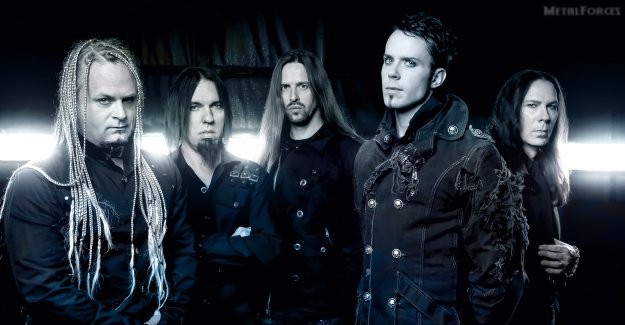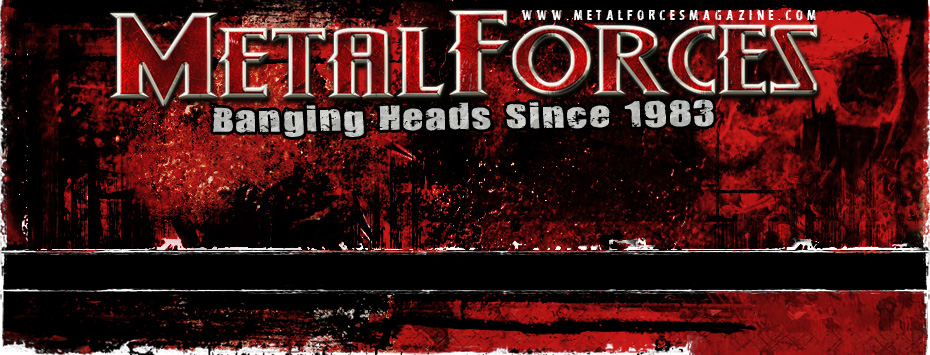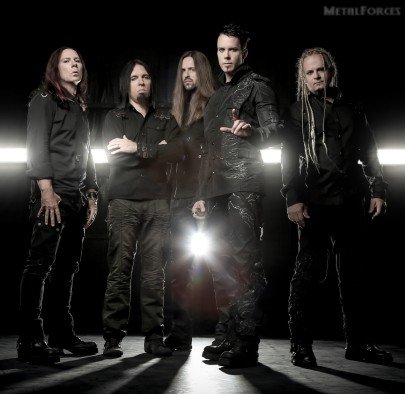
KAMELOT – Under Blue Skies
Anthony Morgan
June 2015
 Kamelot (l-r): Sean Tibbetts, Casey Grillo, Oliver Palotai, Tommy Karevik and Thomas Youngblood |
![]()
Songwriting sessions for May 2015 full-length Haven – the 11th studio record from international symphonic metal outfit Kamelot – mirrored songwriting sessions for preceding studio affair Silverthorn, Silverthorn’s undergoing issue roughly two-and-a-half years earlier in October 2012. Guitarist and co-founder Thomas Youngblood flew to Germany in order to work with keyboardist Oliver Palotai on Haven’s respective tracks.
“We worked really hard on the core songs,” Thomas shares. “We sent them over to Sweden where our singer Tommy (Karevik) worked on melodies and lyrics, and the final touches were done in Germany at our producer’s place. That’s sort of the way the songwriting’s been for the last two albums. The inspiration, I had a little kick on some of these older post-apocalyptic type movies. We’re really seeing that those things are coming to fruition when it comes to technology, so we kind of wanted to incorporate that into the album – into the lyrics, and some of the themes for the songs.”
Albeit incorporating post-apocalyptic themes into Haven’s lyrical fabric, the majority of Haven’s lyrics were penned by vocalist Tommy Karevik. “We discuss ideas when it comes to songs and subjects and stuff, but he’s such a great lyricist,” the axeman enthuses. “I totally love the fact that he can do that, and that I don’t have to do that (laughs). I deal with the music part and I’m also part of the management team, so it’s really great to have such a talented guy in the band. Not only is he a great singer, but he writes amazing lyrics.”
Thomas isn’t particularly receptive towards authoring lyrics himself. “It’s not something that I’m inspired to do,” he admits. “I think I could do it. I’ve done it for a few songs, like ‘Nights Of Arabia’ (from September 1999’s The Fourth Legacy) and stuff like that in the past, but it’s not really… I’m inspired to make melodies with the guitar and the piano, and a drum idea, and stuff like that. That’s my inspiration.”
A given lyrical thread is typically dictated by the melody. “I think it all starts with the melody,” the musician confirms. “The way that we’ve written songs – even from back in the day – is that we have music, and then we write a melody over the music, and then we put the lyrics in last. It’s not like we sit down and write down words like a poem, for example. The way it works for us is we work on the melody first, and then we kind of fit in the lyrics and the words that we think work with the melody.”
Prior to flying to Germany to collaborate songwriting-wise with Oliver – which has been the case across two full-length platters – in the past Thomas would co-write tunes with previous vocalist Roy Khan. “We wrote together either in Florida or Norway,” he remembers. “It was in a similar fashion that I do now with Oliver, but we have a third person in Tommy, working on the melodies and lyrics. We actually even have a fourth person in Sascha (Paeth) the producer, coming in to help with the songwriting. It really has taken a lot of pressure off me, and I think it adds a lot of diversity to the sound. If you listen to a song like ‘Revolution’ for example, that’s probably not something that I would’ve normally written by myself. Oliver kind of wrote the main theme for that song, so that’s a perfect example of what I think you can hear; a diversity based on the songwriting team.”
As well as diversity perhaps, Haven boasts other musical differences when critiqued against past Kamelot platters. “I really don’t like to get caught up in comparing them, because each one has got its own thing,” the composer stresses. “They were written at a certain time and a different time. When we did The Black Halo (March 2005), that was a totally different time in terms of what we were going through personally and creatively. I kind of leave that sort of to the fans and to the journalists to hopefully do that, if they want to compare them – to listen to it, and use that however they want to. For me, it’s another Kamelot record.
“It’s different, which is important. We talked about the diversity in the songwriting. Also, we incorporated some industrial elements in this record. I think the production is a little bit different in terms of the sound. The mastering was done by Jacob Hansen, who is somebody that we’ve never worked with before, and who I think did an amazing job. Those are the core differences. There are different influences; I think there’s some different melodies on the record without straying too far from the Kamelot sound, which is important. Is it our best? I don’t know. Is it our best selling so far? Yeah, which is cool (laughs).”
While ensembles don’t wish to cut the same record time and time again, by the same token, ensembles wish to avoid a complete musical U-turn. “And that’s also an interesting problem for a lot of bands, doing the same album over and over,” Thomas concurs. “Yeah, the fans will know what to expect, but are you gonna grow your fanbase? Are you gonna lose fans that are just tired of hearing the same thing?”
Nevertheless, this arguably isn’t an issue for the likes of AC/DC and Motörhead. “Yeah, exactly,” the axe-slinger agrees. “They have a formula, but they’re also gonna be playing ‘Back In Black’, and that’s gonna be the biggest song they play that night or whatever. For AC/DC it’s not a problem of course, because they’re so massive (laughs). For smaller bands though, you want to definitely be able to grow with each record.”
|
|
In addition, the likes of AC/DC enjoyed the luxury of issuing albums in the 70s and 80s when albums achieved gold and platinum certifications. Nowadays though, building up a group to the point of being financially successful is remarkably more difficult. “Yeah, definitely,” Thomas responds. “I don’t think if I was starting now I’d go for it, because it’s just really difficult. Luckily though, we have a foot in the door. We’re able to tour, and that’s where most bands are able to survive, is touring. With the new bands, you won’t see the same growth. I don’t think you’ll see the same uniqueness that you did before, because there are less labels taking risks with artists and stuff. At the same time though, maybe there are too many bands out there. Too many bands that are just clogging up the whole thing, so maybe that will weed out some of that. I don’t know.”
The true method of gauging an assortment’s actual success is longevity, or a lack thereof. “It was already hard enough back in the 90s to stick around for ten years, and it usually came down to personalities,” the guitarist reckons. “Nowadays though, if you’re a band and you get hot – say within your first three or four years – you’re probably not gonna still be in around in ten years. You probably got hot because were a trend, and trends come and go as we all know. I think we’re really fortunate with our fanbase and the new fanbase, to have a steady, climbing career. It’s been great for us, because we love what we do. Obviously it’d be amazing playing big stadiums, but we’re really fortunate to be able to play big venues. It’s a testament to hard work, but also to having a great, loyal fanbase.”
Stadium concerts are generally headlined by veteran acts such as the aforementioned AC/DC, Iron Maiden, Metallica, and others. Once their ilk have entered retirement in say 10-20 years, an issue will inevitably arise in terms of who’ll take up the mantle. “There’ll be a void,” Thomas observes. “There’ll definitely be a void, but if anybody needs us to step it up, we’ll go in there for them (laughs).”
‘We’ includes vocalist Tommy Karevik, whose chemistry within the Kamelot fold has grown since opening his Kamelot account with Silverthorn. “Touring two-and-a-half years straight,” the band’s co-founder cites. “Obviously the response from the fans for Silverthorn definitely has given him a lot of confidence to be more integrated into the band, and also to maybe put a little bit more of his own signature into what he’s doing now. I think that’s one of the differences you can hear on Haven as well, if we were to compare.”
Tommy’s appointment was originally revealed on June 22nd, 2011, the Swede stepping into a position previously occupied by Roy Khan for a 13-year tenure between 1998 and 2011. “I’m the kind of person that whenever there’s an issue or any kind of situation, I address it immediately and then I never look back,” Thomas reflects. “I think with that situation, that was the perfect and only way to deal with it. We went into the Silverthorn album a 100% confident. It took a lot of work and a lot of analysis in terms of what we felt was the right decision, and at the end of the day, we definitely made the right decision with Tommy. I’m never one of those guys who dwells too much on the past. It’s a good lesson to never let anybody else sort of determine where you’re going in life, whether it be some asshole at work, or whoever it might be, or a boss keeping you down. Take control of the situation, and make things happen.”
An April 21st, 2011 MySpace post by Roy announced his Kamelot exit, although the statement failed to shed light on the reasons behind his departure. “I don’t know,” the performer muses. “I still don’t know the full explanation, and it’s not something that I’m even interested in talking about any more because we’ve basically moved on from that. We definitely made sure that we kept everything classy when it came to talking about it, though. We wish him 100% the best, and I’m totally happy for him because he’s happy. That’s really all that matters, is the guy’s happy. We had to cancel a tour. That was kind of messed up, but other than that, people have to make decisions in their lives. For us, if that’s what it takes to be a happy person, then go for it.”
And as well, Kamelot is happy with Tommy behind the microphone. “Oh yeah, and we’re having a great time,” Thomas adds. “There are no complaints.”
Haven doesn’t exclusively feature Tommy behind the microphone however, the opus including several guests. “We have Troy Donockley from Nightwish playing some cool instrument that he plays on ‘Under Grey Skies’,” the axeman informs. “We toured together with Nightwish in 2012, and became friends. Then we have Charlotte from Delain also on that song. We have Alissa-White Gluz again, who was also on Silverthorn – she also toured with us like crazy on the Silverthorn tour. She’s the lead singer of Arch Enemy. Yeah, she’s also singing clean on this album, which is really cool. I think it’s a different aspect, and something that the fans probably haven’t heard before.”
As well as boasting Arch Enemy frontwoman Alissa-White Gluz as a returning guest, another familiar face in the form of Sascha Paeth sits in the production chair once again. “He’s been with us for like 12 years,” Thomas divulges. “He’s almost like the sixth member of the band. He’s not only an amazing producer, but he’s a crazy, great, good guitar player and he’s got great song ideas. Yeah, he’s just a super-cool guy. He was one of the guys who helped forge the Kamelot sound back with The Fourth Legacy.
“We usually send him demos and ideas, and talk about the different ideas. We redo the demos based on what we all agree with, and then we cut the drums, and then we go in and do guitars. Keyboards this time were done by Oliver in Stuttgart at his own studio, and Tommy did most of the vocals in Germany at Sascha’s place. Yeah, that’s basically the way it works. Then with this record, like I said, we had it mastered by Jacob Hansen, which was really cool. I’ve been wanting to work with him for quite a few years. And yeah, that’s basically how that worked.”
|
|
An album’s master ultimately influences its resultant sound. “The master has a lot to do with the overall volume, but it’s also like a second mix,” the musician describes. “When you first get the mix of an album, you can also tweak the mix to give it more mids or more highs and more bottom end. If you have a bad mastering, it can completely ruin a good mix. Sometimes you can fix a decent mix in the mastering, but if you can have a mixture of a good mastering and good mix, then you’re on your way. Jacob is really good at mastering, and making sure that it’s not too… There’s so many tiny, little nuances that most people don’t even think about, but when you hear the differences, it’s definitely there.”
Of the 11 full-length records among the Kamelot catalogue, not all perhaps enjoy a proficient mix. “The Siége Perilous mix (August 1998) I’ve never really liked,” Thomas reveals. “That was done in Germany. I don’t need to mention the mix guy, but I was never really happy with that mix. I just felt that the balances were kind of unusual. One of my favourite mixes was for The Black Halo; there’s something about that one that is unique and special. A lot of the time, it has to do with the songs. The songs are sometimes different, and so we want each record to sound different. Otherwise, it sounds like it’s coming out of a factory. What I mean with some bands – their records sounding like they come out of a factory – every record has the same sound.
“I don’t think that’s cool, when the drums always have the same sound on each album. Each song has the same guitar sound. There’s a certain sound for guitars, and 80% of the bands have this exact same sound – same drum sound, for example – which is safe, but is it really cool? Is it unique? Is it artistic? We want a killer guitar sound and we want a killer drum sound, but we also want it to be unique. I kind of like the old school way, when bands like Queen and even Deep Purple or Led Zeppelin were like ‘This song needs a different snare’ or ‘Let’s use a different amp on this song than we did on the other song.’ That old kind of approach to creating different pictures with the music.”
An Ivan Colic-directed music video was filmed Haven composition ‘Insomnia’ , meanwhile. “‘Insomnia’ is basically about things in life, all of the pressures that we have in our lives, and it’s a got a lot to do with the pressure of modern society,” the songwriter discloses. “Even if you’re super-confident and successful, there’s still pressures in life that can kind of keep you from relaxing and sleeping. That’s kind of what the basic genesis of that song was about.
“We shot the video for it down in Belgrade, Serbia. Those guys, they also did the Ghost Opera (June 2007) video ‘Rule The World’ and the ‘Sacrimony’ video. Really fun guys to work with. It’s a cool atmosphere down there, and they love Kamelot; they really get what we’re doing. I think that’s a super-important thing, is to have a team – whether it be in the studio, or the video guys – that are also kind of onboard with the vision that you have, so we worked with those guys on the ‘Insomnia’ video. We have a second video that is coming out in a month, which is sort of a continuation of the ‘Insomnia’ video, which is gonna be really cool. I’m waiting for the treatment. I would like to do four for Haven. Right now the plan is to do three, but I would like to do four at some point.”
Cover artwork duties for Haven were principally handled by Stefan Hielemann, with additional art / layout work being undertaken by Gustavo Sazes. “I basically sent him a few ideas, and he sent over some of the first versions,” Thomas tells. “I wanted to add this skull element to the back of it. After that, we pretty much felt like ‘Wow. This is exactly what we need for the cover.’ This cover and probably Poetry For The Poisoned (September 2010) are my two favourite Kamelot covers. I don’t like comparing, but when it comes to covers, I will compare (laughs). To me, the composition is the perfect mixture of class, but also the gothic and darkness. Seth Siro Anton did the Poetry For The Poisoned cover, and he’s like a genius when it comes to mixed media. Hielemann in the past has done some amazing stuff, but I think on Haven, it’s a new kind of standard for him in my opinion. So yeah, those two really match that higher level criteria.”
Haven marks the first Kamelot outing to be issued through Napalm, the inking of the record contract being publicly disclosed on January 14th, 2015. Albums seven through to ten had arrived via SPV / Steamhammer. “Basically our deal with SPV was over, so we had quite a few different labels wanting to sign Kamelot,” the axe-slinger notes. “In the end it came down to two labels, but we felt with Napalm that there was a different sense of priority for the band. That’s basically what it came down to. I think SPV did a really good job on Silverthorn. They did this thing called insolvency, which is basically like a bankruptcy. They did this a few years ago; another company bought the company, and so then the management was different. That’s basically the main reason for us not entertaining going back to them, but the people there are all into metal – at least the guys that work in the office – and they’re all good people.
“They did a really good job on Silverthorn, but I think with Napalm, it’s a different level. I think they’re making some smart signings. They’re working hard. They understand the promotional part of it, but they’re also signing unique bands and they’re diversifying their label, which is important. So yeah, they’re a small, growing label, but they’re definitely growing fast.”
Haven was released on May 5th, 2015 in North America and subsequently on the 8th in Europe, all via Napalm Records (excluding Asia) as part of an exclusive licensing deal through the band’s Kamelot Music LLC.
Interview published in June 2015.
Related Posts via Categories
- SCOTTISH SICKNESS – A Report On The Scottish Death Metal Scene, Featuring BRAINBATH, PUTRID FATE And RANCID CADAVER (October 2022) | Features / Interviews @ Metal Forces
- LARVAE – Join The Hardcore Cult! (June 2022) | Features / Interviews @ Metal Forces Magazine
- TRENCH FOOT – Sacrificing Morals For Gory Obscenities (June 2022) | Features / Interviews @ Metal Forces Magazine
- L.A. GUNS – Trigger Happy (March 2019) | Features / Interviews @ Metal Forces Magazine
- CANCER – Crimes So Evil (November 2018) | Features / Interviews @ Metal Forces Magazine
- U.D.O. – The Tank Drives On (August 2018) | Features / Interviews @ Metal Forces Magazine
- SIEGE OF POWER – Bleeding For The Cause (August 2018) | Features / Interviews @ Metal Forces Magazine
- MOONSPELL – A Taste Of Live Eternity (August 2018) | Features / Interviews @ Metal Forces Magazine
- MONSTROSITY – Dark Matter Invocation (August 2018) | Features / Interviews @ Metal Forces Magazine
- SATAN – Five Magicians (August 2018) | Features / Interviews @ Metal Forces Magazine
|
|







